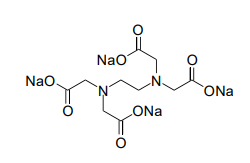Knowde Enhanced TDS
Identification & Functionality
- Chemical Name
- INCI Name
- Cleaning Ingredients Functions
- Cosmetic Ingredients Functions
- Industrial Additives Functions
- Molecular formula
- EDTA-Na₄
- Product Families
- Chemical Structure

Features & Benefits
- Benefit Claims
- Labeling Claims
- HII Features
- Environmental Aspects
Inherently biodegradable. Rapid biodegradation can be obtained under slightly alkaline conditions.
Applications & Uses
- Applications
- Applicable Processes
- Application Format
- Bath & Shower Applications
- Fluids & Lubricants End Use
- Home Care Applications
- I&I Cleaning Applications
- Industrial Additives End Use
Properties
- Physical Form
- Appearance
- Clear liquid
- Miscible in
- Water
- Typical Properties
- Characteristics
- Specifications
- Theoretical Properties
| Value | Units | Test Method / Conditions | |
| Molecular Weight | 380.2 | — | — |
| Chemical Oxygen Demand | approx. 260 | mg/g | — |
| Value | Units | Test Method / Conditions | |
| Crystallization Point | max. -15 | °C | — |
| Value | Units | Test Method / Conditions | |
| Assay (According to Fe-sequestering capacity) | min. 38.2 | — | — |
| Color | max. 150 | — | APHA |
| Density | approx. 1280 | kg/m³ | — |
| NTA-Na₃ Content | max. 0.1 | % | — |
| pH (in 1% w/v Aqueous Dilution) | 11.0-11.8 | — | — |
| Value | Units | Test Method / Conditions | |
| Calcium Content (at pH 5 - 14) | 40.0 | mg metal/g | — |
| Copper Content (at pH 2 - 14) | 65.0 | mg metal/g | — |
| Ferric Content (at pH 1-10) | 60.0 | mg metal/g | — |
| Magnesium Content (at pH 6 - 11) | 25.0 | mg metal/g | — |
| Manganese Content (at pH 3 - 13) | 60.0 | mg metal/g | — |
| Zinc Content (at pH 2-13) | 70.0 | mg metal/g | — |
Storage & Handling
- Storage Conditions
- Store in original packing or in PVC, PP, PE, stainless steel or bituminized tanks.
- Avoid contact with aluminum, zinc, nickel, copper and copper alloys.
- It is advised to re-test the material after three years of storage.